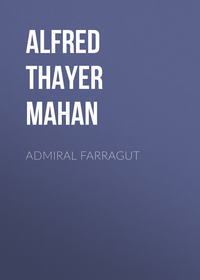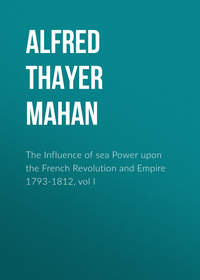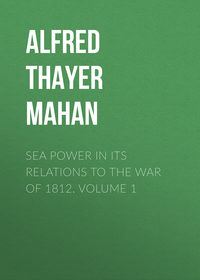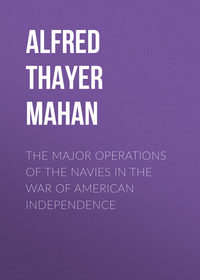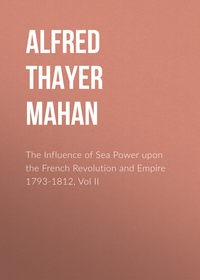 полная версия
полная версияStory of the War in South Africa, 1899-1900
From the simply defensive point of view, a line of works arranged consecutively around such a stationary centre has no flanks to be turned, but resembles a circle or other continuous curve which returns into itself. Like a straight line, such a curve may be broken by superior force; but until that is done the weakness of flanks does not exist. Moreover, succour can be more quickly sent from a centre to every threatened point of the circumference than from the middle of a line of equal length to its extremes. A circle, therefore, is the most compact disposition for defence, and so most ideal for smaller numbers. It is concentration in its most effective form, while sacrificing nothing in elasticity and flexibility of motion.
These are the intrinsic defensive advantages—as distinguished from the offensive threat to the enemy's communications—secured to the weaker party by a permanent position, and these are its compensations for the loss of open communications which have been deliberately abandoned.
In Natal, at the end of October, 1899, the British army was much inferior to the enemy in both numbers and mobility; and while several lines of defence were to be found in the region behind, as was shown by the stubborn resistance which the Boers, when in turn outnumbered, made at the Tugela, these positions were open to the danger of being turned by superior numbers or superior rapidity; still more when these two were combined. In fact, much of the subsequent Boer success in defence resulted from the fact that, acting on the inside of an arc, with the advantage of interior—shorter—lines, they also moved over the latter with greater speed, owing to their distinguishing characteristic as mounted troops. They had particular facilities, in a word, for accumulating successful numbers at a threatened point of a stationary defence, which the British would not have had in an active campaign of retreat.
It became therefore advisable, if not imperative, for the British commander in Natal to resort to a stationary defence for the preservation of his division, and to place himself for offensive purpose upon the flank of the enemy's possible line of invasion, in order to deter him from further advance. As to situation, Ladysmith was clearly indicated by the reasons before stated, and especially because there was there accumulated a great quantity of ammunition, provisions, and other supplies, which not only should not be allowed to fall into the hands of the Boers, but also would be essential to the maintenance of the garrison, if relief were long delayed, as it proved to be. That this contingency was foreseen, and as far as possible provided for, has been shown by subsequent utterances of Sir George White. "From the moment I saw the situation in Natal, I was certain I should be pressed back by superior numbers, and have to hold Ladysmith, and I knew that the enemy had guns with which I could not hope to cope with my 15-pounder field guns. Therefore I telegraphed for the naval guns. It was a question of a race for them, and Captain Lambton was the right man to win that race. He won only by a short head."16
This, then, was the function which the current of events assigned to Ladysmith, and the part which it bore to the subsequent development of the war. Discussion has been thus long because, in the author's judgment, White's action in shutting himself up in the place, and the admirable tenacity of himself and of the garrison in their resistance, were the shaping factors in a contest the ultimate result of which was probably certain in any event, but which in feature and occurrence would have been very different had Ladysmith either not been occupied or proved incapable of protracted resistance. As so often markedly happens, when a correct decision has been made, circumstances seemed to work together to favour the consequences. The respite given to the garrison by Joubert, who did not attack until November 9, allowed opportunity to regularize and further to develop the system of defence, so that on November 6 a press censor telegram, brought out successfully by a Kaffir runner, read, "Position here now believed to be entirely safe; greatly strengthened in the last twenty-four hours." The opportune arrival of the naval guns also, though by so narrow a margin of time, decisively influenced the outcome. "Had it not been for these guns," said Sir George White, after his return to England, "the guns of the Boers would have been brought up very much nearer to my defences of Ladysmith, and it would enormously have embarrassed my powers of resistance and would have added enormously to the mortality of my garrison. Not once or twice in our rough island story have the naval officer and his men come in the nick of time, and the siege of Ladysmith was but one instance added to these happy advents."
As before said, Ladysmith is surrounded on three sides by hills which overtop it; railroad lines and stations, indeed, do not commonly prefer summits to valleys. On the 30th of October the Boers had already mounted a 40-pounder gun on Peppworth's Hill, north of the town, with which on that day they opened fire at a distance of over 6,000 yards, much outranging the army field artillery. It was in connection with the general sortie of the garrison to seize that position that the disaster of Nicholson's Nek was incurred.
This first threatening outlook was materially modified by the arrival the same day of the six naval guns from Durban, two of which were of power equal to the Boers' heavy pieces, and all of a range superior to those previously at White's disposal. By the 3rd of November a second long gun had been placed by the besiegers some 8,000 yards—between four and five miles—south-east of the town, upon Mount Umbulwani; from which, and from an eminence known indifferently as Lombard's Kop and as Little Bulwana, three miles to the northward, and also east of the place, the worst of the heavy gun fire upon the town itself, as distinguished from the lines of defence, seems to have proceeded. On the 28th the Boers had established within 5,000 yards—less than three miles—of the western defences a third 40-pounder, to which, we learn from Joubert's despatches, his gunners with grim military humour gave the name of "Franchise"—in mockery, doubtless, of the British Government's demands on behalf of the Uitlanders. It may be mentioned here that throughout the war the Boers have shown a remarkable facility in transporting these heavy cannon, placing them with surprising rapidity in positions unexpected by their opponents. On the 29th the besieged could count twenty-six guns in place upon the lines of attack; but of these, at that time, only the three specified were guns "of position," to be reckoned as units of a siege train. The British defensive works, when finally established, measured in circuit some sixteen miles. The range of the heavier hostile guns, as revealed by their early practice, compelled an extension to this degree, in order to hold them back beyond easy command of the town. Fortunately this perimeter, which would indicate the enclosed area to have a diameter of from five to six miles, could be manned without overtaxing the numbers of the garrison. At the moment of investment the British force fit for duty was 572 officers and 12,924 men; total, 13,496. Of these, during the siege, 88 officers and 732 men were killed or wounded; but sickness and want of food had so far further reduced the numbers that on the day of relief there were of effectives only 403 officers and 9,761 men, and of these it was significantly added that "they are the only troops fit to do even a two-miles march."17
Long before this condition of destitution and debility was reached the besiegers found their hands so occupied by the British relieving forces that the besieged had little more to do than to hold on. When the danger to Ladysmith had decided the British authorities to depart from the original plan, of a single forward movement in mass through the Free State, and to organise instead a double advance, with divided forces, for the simultaneous relief of Ladysmith and of Kimberley—as well as certain other subsidiary operations by French and Gatacre—heavy reinforcements were at once directed upon Natal. Hildyard's brigade, which had left England before the news of Talana Hill was received, went on at once from Cape Town without disembarking, reaching Durban before November 17. Lieutenant-General Sir Francis Clery continued on to the same port from his original destination, Port Elizabeth, and upon arrival, November 18, took command of all the forces in the colony south of Ladysmith. He was followed exactly a week later by the Commander-in-Chief, Sir Redvers Buller, drawn in person by the irresistible logic of events to the scene which his own action, or that of the Government, had determined to be the chief among several centres of active operations.
Meantime, since the day of investment, much had been happening, and conditions were rapidly taking shape. Upon the 9th of November Joubert directed an attack upon the defences of Ladysmith. This delay of a week has not yet been explained, and is to be justified only upon grounds of necessity, in the Boer commander's inability, however occasioned, sooner to get his numbers together, concentrated and disposed for so grave an enterprise. The solution is probably to be found partly in his own natural temperament, which his previous career, though political rather than military, indicates to have been cautious, and lacking in the aggressive quality that has given President Kruger, in civic contests, a continuous triumph over his more cultivated and progressive, but less combative, rival.
It is to this trait of wariness, seeking to compass ends by indirection and compromise rather than by open conflict, that Joubert's failure to achieve success in public life has been plausibly attributed, and from it arose the nickname "Slim (crafty) Piet" attached to him by his countrymen. "It was this want of assertiveness and of determination in following any marked line of action which prevented Joubert from playing a great part in the fortunes of the Republic. Opportunities occurred again and again after the advent of the Uitlanders when a vigorous assertion of himself would have placed him in a position to defeat Mr. Kruger. But the habit of indolence, so often found associated with a big physical frame, and a certain element of Scotch 'canniness,' which led him to refuse to accept risks, prevented his offering serious opposition to the Kruger clique."
This estimate of Joubert's characteristics is recently confirmed by two sympathetic observers from within the Boer lines. "Mr. Davitt, in a letter from Kroonstad to the Dublin Freeman's Journal, declares that the Boers were not at all dismayed by the death of General Joubert, which they agreed was in no sense a misfortune. He was too merciful in his notions of warfare. Ladysmith could easily have been taken on more than one occasion had Joubert not vetoed the proposed assaults."18 The second correspondent relates that General Joubert overruled the desire of the burghers to assault Ladysmith, saying "at a War Council that the city was not worth to the Boers the lives of 500 burghers." If Joubert really said that, he ought unquestionably to have been at once relieved from command; but as the incident is preceded by the statement that "the burghers were confident of their ability to take it in a hand-to-hand fight, notwithstanding that the English outnumbered them more than two to one,"19 the source of the correspondent's information is open to some question.
To make war without running risks—not mere risk of personal danger, but of military failure—has been declared impossible by the highest authority. Yet such a temperament, betrayed in politics, being constitutional, will enter into all actions of life, and one is not surprised to read that "this characteristic of caution was the chief mark of Joubert's conduct in the field as a military commander. His idea of warfare was to act ever on the defensive." Let this be qualified so far as to say that his idea appears always to have been to act within limits of safety, to consider self-preservation—the preservation, that is, of his own forces—more important than the destruction of the enemy, and we have a view, not of Joubert only, but of his race, which goes far to explain the failures at Ladysmith, Kimberley, and Mafeking, and likewise the inefficient action at that early period of the war when alone success was locally possible, and, if locally attained, might have even compassed an ultimate victory. If to this idea be linked that which is closely akin to it—of attaining results, not by superior dexterity in the use of means, but by subtlety and ambush—and we have the explanation both of the numerous artful traps into which British detachments were led, like game into the snare of the hunter, and yet also of the sure failure to achieve success in war, for the craft of the hunter is not the skill of the warrior.
The cognate words "stratagem" and "strategist" sufficiently indicate that craft and wile are part of the professional equipment of great warriors, but with them these are not, and cannot be, predominant. Their skill is not so much to contrive success by deceiving an enemy as to command it by local superiority of force, either exerted in violence, or imposing submission by mere evidence of overpowerment. Circumvention with them aims at permanent results which it alone cannot obtain. It is but a means to the end, which is the crushing, the military annihilation, of the enemy. That can be accomplished only by force, not by mere guile. In his temperament, as shown by his action, Joubert reflected the fighting characteristics of his people, of whom he has been the most conspicuous military representative, honoured by friend and foe alike for his fearlessness, his intelligence, and his humanity. Courage of the highest proof as regards personal danger, but not the courage that throws away the scabbard, much less that which burns its ships. The hunter, meeting superior strength with superior cunning, without even the very least willingness to lose his life in order to carry his end, may be brave even to recklessness; but he rejects habitually the tone of mind distinctive of the soldier, who counts life naught if only by its sacrifice the end may be attained, or honour preserved. In so far, that element of stupidity which has been somewhat lavishly attributed to the British officers' too single-minded attention to their end, to the exclusion of care for their own persons and those of their men, has a military value not only great, but decisive. The quality needs direction and control, certainly; but, having been reproached for now two centuries, the question is apt—Where has it placed Great Britain among the nations of the earth?
The assault of November 9 began, as is usual in such cases, with a heavy artillery fire, intended to shake the endurance of those subjected to it. The Boer guns opened at 4 A.M., and under their cover the assailants moved forward. The attack was made from all sides, but the principal effort came from the northward, between the railroads leading north-east to Glencoe and north-west to the Free State. As before said, particulars are wanting; but the British had only to hold their own, except when by a rush, after a repulse of the enemy, they gained ground over which the latter had passed; whereas the Boers, having to break cover frequently in order to advance, underwent necessarily the greater burden of exposure and of loss. How large this was is still uncertain. Sir Redvers Buller, on the 5th December, telegraphed to the War Office that it was "very difficult to make any statement as to the enemy's losses. For instance, at Belmont, 81 of their dead were accounted for; they gave 15 as the number of killed. There is every reason to believe that in the fight at Ladysmith, on November 9, the enemy's loss was over 800 killed and wounded." The Boer practice of removing or concealing their slain has already been noted. The British casualties on this occasion were at the time reckoned at about 100. Whether subsequent estimates materially changed this figure is not particularised; but probably it is nearly correct, for the total losses during the investment, exclusive of the great assault of January 6, were only 355. The enemy were effectually repulsed all along the line, and the fighting was mostly over by 11 A.M. At noon a salute was fired, in honour primarily of the Prince of Wales's birthday; but, incidentally, doubtless, it expressed exultation over the garrison's own achievement.
Nearly two months elapsed before the attempt to carry the works by storm was renewed, and then, doubtless, because it had been recognised that there was at least a dangerous probability that the place might hold out, until it was relieved by the immense forces known to be accumulating. But the immediate result of the failure of the 9th was to dispose the Boer authorities not to risk further slaughter, but to trust rather to the slow process of famine for overcoming an endurance which neither they, nor probably the British outside, then thought could be so long protracted.
Joubert therefore settled down to an investment and bombardment. Immediately following this determination, and probably consequent upon it, there were organised a number of raids upon the Natal territory to the southward. These, though simultaneous in execution, and therefore mutually supporting, were made by bodies apparently individually independent; sharing in this a characteristic commonly met in the Boer operations, and facilitated at once by their individualistic habits of life, their knowledge of the country, and their freedom from the organic interdependence which to regular troops becomes a second nature. Every Boer organisation seems susceptible of immediate dissolution into its component units, each of independent vitality, and of subsequent reunion in some assigned place; the individuals passing easily as innocent wayfarers or peasants among the population, with which they readily blend. The quality has its strength; but it has also its weakness, and the latter exceeds. This capacity for undergoing multifold subdivision, with retention of function by the several parts, is characteristic, in fact, of the simpler and lower forms of life, and disappears gradually as evolution progresses to higher orders. In all military performance, it is not the faculty for segregation that chiefly tells. It is the predisposition to united action, the habit of mutual concert and reliance. By this, concentration of purpose, subordination to a common impulse, ceases to be an effort, becoming the second nature of the man; and concentration of action, not merely in great operations but in the inner spirit, is the secret of success in war. Individual, intelligent self-direction is not, however, thereby excluded. The two are complementary elements of the highest personal efficiency; but they must be regarded in their due relations and proportions. The individualistic tendency is that of the natural man, of the raw material, of the irregular trooper. Educated in the trained soldier into due subordination to the superior demands of military concert, it remains an invaluable constituent of military character; but where existing in excess, as it does prior to training, it is far more harmful than beneficial. In considering the experiences of a war of the kind before us, these facts should be kept clearly in mind; for under the peculiar conditions of countries partly or wholly unredeemed, as the American wilderness of a century or so ago, or South Africa to-day, the special experience of the inhabitant confers local aptitudes which the trained soldier needs to acquire, which place him for the moment, and in so far, in a position of inferiority, and in consequence of which hasty impression lightly reaches the erroneous conclusion that greater military efficiency resides in individual liberty of action, than in imposed habits of subordination and concert of movement. It is not so. The exception should not be mistaken for the rule, nor the occasional for the permanent.
Incidentally to the process of investment, the Boers had already moved in considerable numbers south of Ladysmith, and had established batteries on Grobler's Kloof, a ridge two or three miles west of the railroad, overlooking the Tugela from the north. Thence they had opened fire on the 2nd of November against Colenso, the town and railway station upon the southern bank, and against Fort Wylie, upon the northern, just to the east of the road. Colenso and Wylie were consequently evacuated by the small British forces there present, and on the 4th it was announced officially that they had retired to Estcourt, twenty miles to the southward—twenty-seven by the railroad. This marked the furthest point of the British retreat; but the fewness of the troops that there made their stand exposed them for some days to very serious danger, had the object of the Boers been, as was by some alleged, with firm purpose to destroy whatsoever of force or of facilities existed to further the advance of relief to the invested garrison, and not merely raiding with a view to increase their resources in the positions they had determined to hold, around Ladysmith and on the Tugela.
Up to the 15th of November an armoured train was sent out daily from Estcourt to reconnoitre, but on that day, having pushed too far north, it was intercepted on its return by an advanced party of the enemy, who, by loosening a rail, threw it off the track. A hundred British, more or less, were here captured; among them Mr. Winston Churchill, a war correspondent. Three days later, November 18, there were seen from Estcourt the advanced patrols of the various raiding parties, who were sweeping the country on both sides of the railroad over a front of thirty miles or more, from Weenen on the east to Ulundi on the west. On the 21st they were reported in the direction of Greytown, forty miles east of Estcourt and the same distance from the railroad, which here runs south-east, and also at Impendhla, twenty-five miles west of the road. Their advance was pushed close to the Mooi River, which the railroad crosses twenty miles to the southward of Estcourt, and there artillery shots were exchanged with the camp where Sir Francis Clery was assembling the reinforcements arriving at Durban—the beginnings of the force destined to the relief of Ladysmith.
Communication of Estcourt with Mooi River was for a short while interrupted, both by rail and by telegraph, the enemy occupying Highlands Station, thirteen miles to the southward, on the 20th, and also a position commanding Willow Grange, midway between Highlands and Estcourt. At no time, however, did the Boers make any serious demonstration, looking towards the permanent isolation of the place; nor was there any attempt to capture it. The whole movement, as it resulted, was simply a raid, and nothing more, with no apparent objects except to secure supplies, and, while so engaged, to insure their own safety from molestation by occupying positions of command, which facilitated their defence and—by menace or otherwise—imposed obstacles upon the movements of the British. A certain amount of outpost skirmishing of course occurred, and on the night of the 22nd some 4,000 British, under General Hildyard, moved, by way of Willow Grange, to attack Beacon Hill, which overlooks Estcourt from the west. The Boers were in force there, and upon still higher ridges farther to the westward. A sharp engagement took place that night, in which the British first carried the position, but afterwards retired, leaving it to be reoccupied by the enemy. The movement on their part seems to have been simply precautionary, a sharp rap to check the over-confidence of the opponent, and to deter him from pushing attacks upon the railroad, which for the time being might be inconveniently successful; the reinforcements from Durban having as yet only partially come up, and the organisation for advance being still incomplete. The British loss was 11 killed, 67 wounded.20
No attempt on a large scale was made to arrest the Boer raiding operations. From this, and from their mutually independent character, it has resulted that the numbers engaged in them have remained very uncertain, not having been observed or tested by the usual military methods. By one correspondent on the spot they were estimated at not over 5,000;21 by another, equally present, at from 7,000 to 12,000.22
Sir Francis Clery had apparently determined to concentrate his entire effort upon organising the relief of Ladysmith, and was not to be drawn off by side events, however disastrous to local interests. The British force at Estcourt and at Mooi River were considered safe, and the enemy's advance in fact did not extend in any force beyond the latter. Very shortly after the affair at Willow Grange the tide began to ebb. The precise cause for this is still a matter of surmise. It may be that Joubert considered he had gathered in all that was needed to supply his positions around Ladysmith and behind the Tugela; it was reported at the time that 12,000 head of cattle were among the spoils. It may be that he found the British force, although yet only partially concentrated and organised, too strong to justify a more extended movement. It had been rumoured that he purposed to capture, if possible, Estcourt and Mooi River, and even to push on to Pietermaritzburg, with the view of stopping the relief column as far as possible from its point of destination. Such an effort was strictly accurate from the strategic standpoint, and accordingly his whole movement may have been of the nature of a reconnaissance in force, to receive greater development if circumstances favoured, and in any event to impose delay by destroying the roads. To this, however, it must be replied, even in the ground covered, the injury to the rail, though often attempted was nowhere serious, except where culverts or bridges offered vulnerable points.





